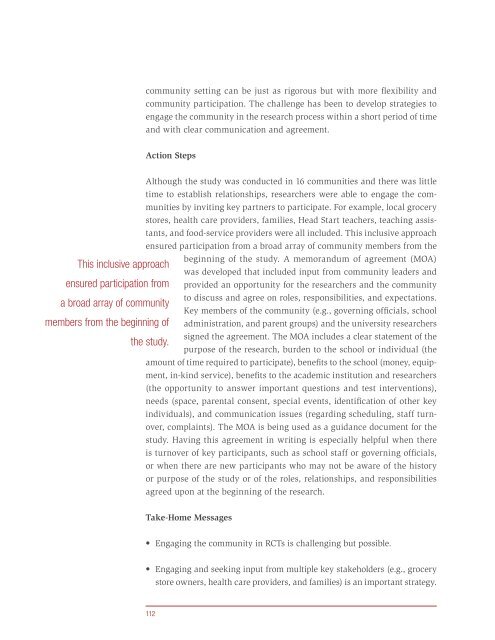Principles of Community Engagement (Second Edition)
Principles of Community Engagement (Second Edition)
Principles of Community Engagement (Second Edition)
You also want an ePaper? Increase the reach of your titles
YUMPU automatically turns print PDFs into web optimized ePapers that Google loves.
community setting can be just as rigorous but with more flexibility and<br />
community participation The challenge has been to develop strategies to<br />
engage the community in the research process within a short period <strong>of</strong> time<br />
and with clear communication and agreement<br />
Action Steps<br />
This inclusive approach<br />
ensured participation from<br />
a broad array <strong>of</strong> community<br />
members from the beginning <strong>of</strong><br />
the study.<br />
Although the study was conducted in 16 communities and there was little<br />
time to establish relationships, researchers were able to engage the communities<br />
by inviting key partners to participate For example, local grocery<br />
stores, health care providers, families, Head Start teachers, teaching assistants,<br />
and food-service providers were all included This inclusive approach<br />
ensured participation from a broad array <strong>of</strong> community members from the<br />
beginning <strong>of</strong> the study A memorandum <strong>of</strong> agreement (MOA)<br />
was developed that included input from community leaders and<br />
provided an opportunity for the researchers and the community<br />
to discuss and agree on roles, responsibilities, and expectations<br />
Key members <strong>of</strong> the community (e g , governing <strong>of</strong>ficials, school<br />
administration, and parent groups) and the university researchers<br />
signed the agreement The MOA includes a clear statement <strong>of</strong> the<br />
purpose <strong>of</strong> the research, burden to the school or individual (the<br />
amount <strong>of</strong> time required to participate), benefits to the school (money, equipment,<br />
in-kind service), benefits to the academic institution and researchers<br />
(the opportunity to answer important questions and test interventions),<br />
needs (space, parental consent, special events, identification <strong>of</strong> other key<br />
individuals), and communication issues (regarding scheduling, staff turnover,<br />
complaints) The MOA is being used as a guidance document for the<br />
study Having this agreement in writing is especially helpful when there<br />
is turnover <strong>of</strong> key participants, such as school staff or governing <strong>of</strong>ficials,<br />
or when there are new participants who may not be aware <strong>of</strong> the history<br />
or purpose <strong>of</strong> the study or <strong>of</strong> the roles, relationships, and responsibilities<br />
agreed upon at the beginning <strong>of</strong> the research<br />
Take-Home Messages<br />
• Engaging the community in RCTs is challenging but possible.<br />
• Engaging and seeking input from multiple key stakeholders (e.g., grocery<br />
store owners, health care providers, and families) is an important strategy<br />
112

















